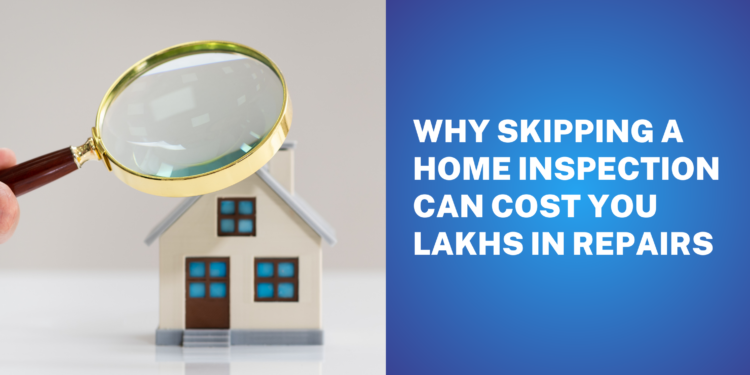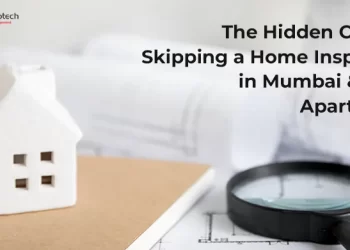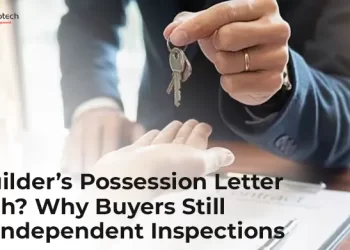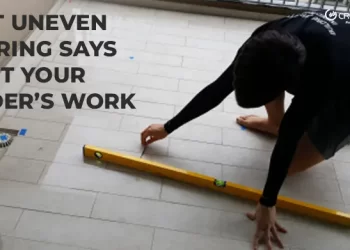Buying a home is a dream for many, but it is also a huge financial decision. While homebuyers focus on location, price, and aesthetics, one crucial step is often ignored—a professional home inspection. Skipping this step can lead to hidden defects, unexpected expenses, and major repair costs that could drain your savings.
A home inspection helps uncover structural, electrical, plumbing, and safety issues before you finalize the deal. Without it, you might end up investing in a property with severe defects that require lakhs of rupees in repairs.
In this article, we will explore why a home inspection is essential, what problems it can detect, and how skipping it can result in huge financial losses.
How Skipping a Home Inspection Can Cost You Lakhs
Many buyers assume that if a home looks good, it must be in perfect condition. However, hidden defects may not be visible at first glance. Here’s how skipping a home inspection can result in major financial losses.
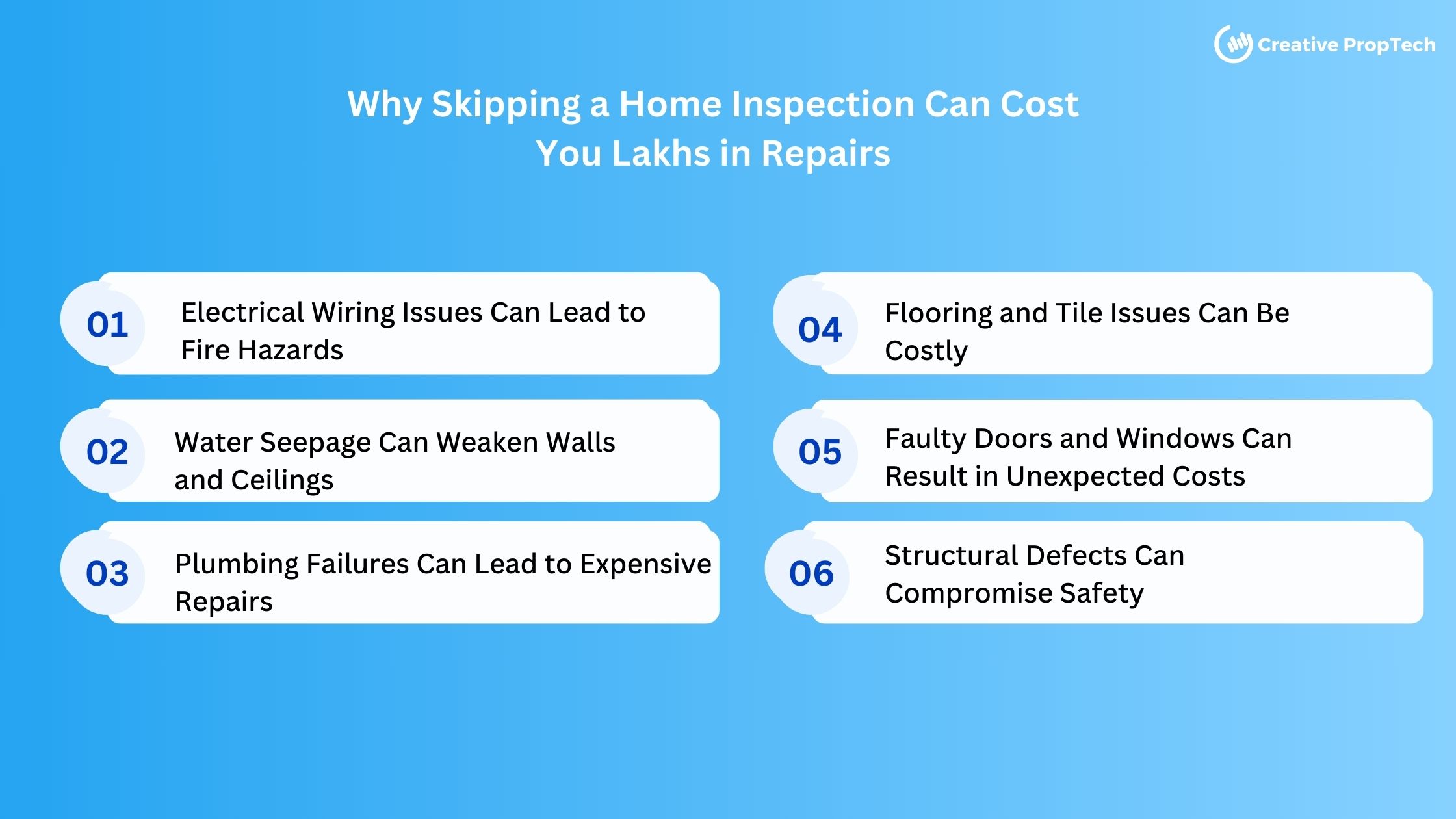 Electrical Wiring Issues Can Lead to Fire Hazards
Electrical Wiring Issues Can Lead to Fire Hazards
Old or faulty electrical wiring is one of the most common and dangerous issues found in Indian homes. While electrical problems may not be immediately visible, poor wiring, loose connections, and outdated electrical panels can pose a serious fire hazard.
According to reports, electrical faults are one of the leading causes of house fires in India, making it crucial to ensure the safety of a home’s electrical system before purchase.
Many homes, especially older constructions, may have worn-out or aluminium wiring, which is no longer considered safe by modern standards. Improperly installed or substandard electrical components can lead to short circuits, flickering lights, frequent power outages, and overheating.
Additionally, in some cases, poor earthing and lack of circuit breakers increase the risk of electric shocks, putting both residents and appliances at risk.
Potential Repair Cost: ₹15,000 – ₹1,00,000
Water Seepage Can Weaken Walls and Ceilings
Water seepage is one of the most overlooked yet expensive problems in Indian homes. What may initially appear as small damp patches or minor discolouration on walls and ceilings can often be a warning sign of a much larger issue.
Water seepage usually originates from plumbing leaks, poor waterproofing, or cracks in the roof and walls, gradually spreading and causing extensive damage over time.
Ignoring early signs of seepage can lead to serious structural weakening, as continuous exposure to moisture can deteriorate concrete, corrode steel reinforcements, and create gaps in walls. This, in turn, reduces the overall lifespan and safety of the home.
Additionally, persistent moisture can cause paint peeling, wallpaper damage, and bloating of wooden structures, making the house look worn out and unappealing.
Potential Repair Cost: ₹20,000 – ₹1,50,000 (or higher for extensive waterproofing and structural repairs)
Plumbing Failures Can Lead to Expensive Repairs
Plumbing issues are one of the most commonly overlooked problems when purchasing a home. Since pipes, drainage systems, and water lines are mostly hidden behind walls and under floors, many buyers fail to notice defects until they start facing persistent leaks, clogged drains, or inconsistent water pressure after moving in.
What may seem like a minor leak or slow drainage can quickly escalate into serious water damage, mold growth, and costly repairs.
Leaky pipes are particularly problematic because they not only waste water and increase utility bills but also cause dampness and seepage inside walls and ceilings. Over time, continuous moisture weakens the structural integrity of the home, leading to cracks, stains, and even damage to electrical wiring running through the walls.
In severe cases, hidden leaks may compromise the foundation of the house, leading to expensive structural repairs.
Poor drainage is another significant issue that can cause flooding, water stagnation, and foundation damage. Many homes, especially older ones, have improperly designed or clogged drainage systems that lead to water backup, damaging floors and outdoor areas.
Without proper drainage, excess water can accumulate around the house, causing soil erosion and cracks in the foundation.
Flooring and Tile Issues Can Be Costly
The flooring of a home plays a vital role in both aesthetics and functionality, but many homebuyers overlook its condition during the purchase process.
At first glance, the floors may appear clean and polished, but underlying defects such as cracked tiles, uneven surfaces, hollow spaces, or poor installation can lead to long-term maintenance headaches and expensive repairs.
Cracked tiles are not just an eyesore; they can indicate poor-quality materials, structural movement, or improper installation techniques. If not addressed in time, cracks can spread, leading to further breakage and potential tripping hazards.
In homes with marble or granite flooring, cracks or chips may require expensive replacements, as matching the exact material and design can be difficult.
Uneven flooring is another common yet unnoticed issue. Improper levelling, substandard raw materials, or poor workmanship can result in uneven tile placement or gaps between flooring materials.
Over time, these imperfections worsen with foot traffic, causing discomfort and requiring extensive repairs. If the flooring was not properly laid, moisture can seep through gaps, leading to water damage, mold growth, and deterioration of the base structure.
Potential Repair Cost: ₹25,000 – ₹2,00,000
Faulty Doors and Windows Can Result in Unexpected Costs
Doors and windows play a crucial role in home security, insulation, and overall functionality, yet they are often overlooked during the home-buying process.
Misaligned doors, loose hinges, damaged frames, or faulty locks can compromise the safety and energy efficiency of a home, leading to additional expenses after purchase.
Poorly fitted doors and windows can cause air leaks, increasing electricity bills by forcing air conditioners or heaters to work harder.
Over time, gaps in window frames can also allow moisture to seep in, leading to wood warping, mold growth, or rust formation in metal fixtures. These small defects, if ignored, can result in higher maintenance costs and frequent repairs.
Potential Repair Cost: ₹10,000 – ₹50,000
Structural Defects Can Compromise Safety
A home’s structural integrity is one of the most critical factors determining its safety and longevity. However, major cracks in walls, weak beams, and shifting foundations can go unnoticed during a casual property visit.
These structural defects not only weaken the stability of the home but also pose long-term safety hazards for residents. If these issues are not detected early, repairing them can be extremely expensive and, in severe cases, may require extensive reconstruction work.
One of the most common structural defects found in homes is foundation instability. This occurs when the ground beneath the property shifts, leading to visible cracks in the walls and uneven floors.
Foundation issues can arise due to poor construction, soil movement, or water seepage, and they often worsen over time if left unaddressed. In extreme cases, a weak foundation can cause walls to tilt, doors and windows to misalign, and even structural collapses, leading to major repair expenses and safety risks.
Potential Repair Cost: ₹50,000 – ₹5,00,000 (or higher for extensive structural repairs)
FAQs
1. Is a home inspection necessary for a newly constructed home?
Yes, even newly built homes can have hidden structural, electrical, or plumbing issues. Poor workmanship, improper installations, or missed quality checks during construction can lead to long-term defects. A professional home inspection ensures that the new home meets safety and quality standards, preventing unexpected repair costs in the future.
2. How does a home inspection help in negotiating the property price?
A home inspection provides a detailed report on structural integrity, plumbing, electrical systems, and other critical components. If the report highlights major defects or repair needs, buyers can use it to negotiate a lower price or ask the seller to fix the issues before closing the deal. This can result in significant savings and ensure a better investment.
3. Can a home inspection detect water seepage and plumbing issues?
Yes, professional home inspectors use moisture meters, infrared cameras, and pressure tests to detect hidden leaks, dampness, and faulty plumbing systems. This helps identify seepage behind walls, weak water pressure, or pipe leaks that may not be visible during a regular walkthrough, allowing buyers to address them before purchase.
4. What are the most expensive repairs that a home inspection can help avoid?
A home inspection helps identify costly repairs such as foundation cracks, electrical wiring faults, roofing issues, structural weaknesses, and water damage. These repairs can cost anywhere between ₹50,000 to ₹5,00,000 or more, making an inspection a small investment compared to potential future expenses.
5. How long does a home inspection take, and when should it be scheduled?
A home inspection typically takes 2-4 hours, depending on the property’s size and complexity. It should be scheduled before finalizing the property purchase so that buyers have enough time to review the inspection report, negotiate repairs, or reconsider their decision if major defects are found.
These FAQs provide clear insights into why a home inspection is a crucial step in the home-buying process and how it saves homeowners from unexpected expenses and safety hazards.


